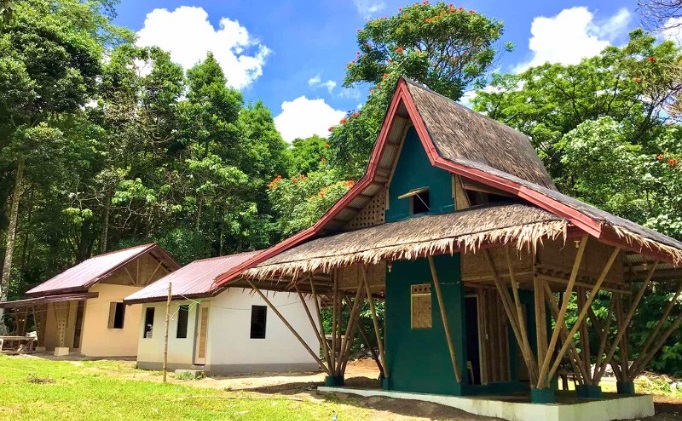
Base Bahay Foundation, Inc. and Hineleban Foundation today showcased three model houses at Hineleban’s Tuminugan Farm in Bukidnon which were designed and built using Cement-Bamboo Frame Technology (CBFT) as housing prototypes for future affordable housing projects in the region.
Visitors may view the model houses as part of Tuminugan Farm’s walking farm tour. A Mindanao-inspired design graces each of the model homes, built in three sizes: the standard Base Bahay house with a floor area of 25 sq m; a medium-sized 30.6 sq m version that comes with a porch; and the largest, a 66.44 sq m home complete with a ground floor dedicated to service functions, a second floor for bedrooms, and a loft area that can be used as storage or as an additional sleeping area.
By giving the public access to the homes, the Hineleban and Base Bahay Foundations hope to create more awareness around the use of sustainable materials such as bamboo in future housing initiatives in Mindanao; to showcase the use Base Bahay’s Cement Bamboo Frame Technology (CBFT) for housing; and to encourage more developers of affordable housing to consider the use of bamboo–a material abundant across Mindanao and BARMM – as a sustainable building material.
Explains Base Bahay General Manager Pablo Jorillo: “As a foundation that provides alternative building technologies, we look to widen our network of partners to build more quality socialized homes for more Filipinos –homes that are comfortable, affordable, disaster-resilient, ecologically friendly, and leave a positive social impact.”
This latest initiative borne of the partnership between the Base Bahay and Hineleban Foundation supports Hineleban Foundation’s objective of inspiring more organizations to help provide sustainable livelihood and more permanent housing to Bangsamoro and the Indigenous people in Mindanao.
“Building of permanent houses in the BARMM region is symbolic in an area where conflict has caused people to move constantly. These houses give communities the opportunity to ground themselves in their homes and land,” Jorillo adds. “Investing in infrastructure is also a signal of development in this region.”
Aside from hosting the model houses, Hineleban Foundation has been a bamboo supply partner of Base Bahay through their network of local and sustainable farms that produce high-value crops. The foundation harvests and treats bambusa blumeana and dentrocalamus asper which are used for Base’s social housing projects.
To date, Base Bahay has built more than 1,200 CBFT houses across the Philippines sheltering about 5,000 individuals in 12 communities. Base works continuously to optimize the use of bamboo in permanent housing. This will also help the communities to avoid the constant rebuilding of houses whenever calamity strikes. The treatment of bamboo poles also enables the construction of low-maintenance houses, as the treatment makes them termite-resistant. CBFT houses also provide good thermal comfort, which can help families save more on electricity consumption.
“We hope that, through our efforts, developers see the value of bamboo–a plant indigenous to our country and grows in abundance here. Despite this, 50 percent of homes are still built with resource-intensive concrete and imported steel,” Jorillo says. “Bamboo’s full potential has yet to be realized: It is long-lasting and renewable, and it is now easier, through our technology, to source, treat, and manufacture.”


2 Comments
Experience continuous financial accuracy with Rocket Bookkeeper’s monthly bookkeeping services, meticulously designed to provide routine monitoring and precise record management.
Thank you for this very inspiring blog about climate-resilient bamboo home prototypes . This is a very nice thought to read and a motivation for others as well.